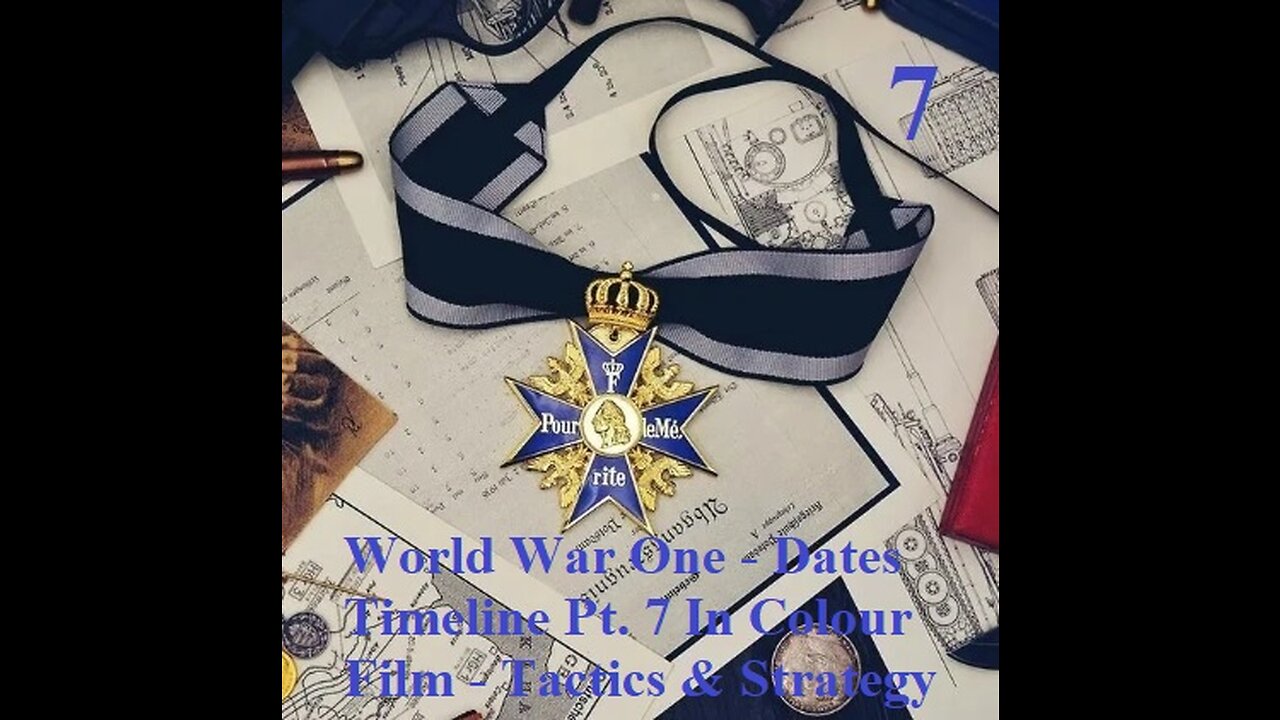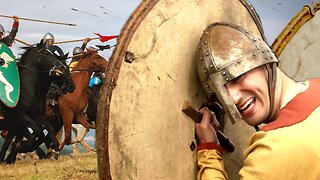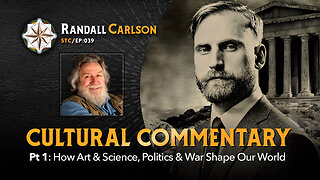Premium Only Content

World War One - Dates & Timeline Pt. 7 In Colour Film - Tactics And Strategy
World War I Pitted Germany, Austria-Hungary and the Ottoman Empire against Great Britain, the United States, France, Russia, Italy and Japan. New military technology resulted in unprecedented carnage. By the time the war was over and the Allied Powers claimed victory, more than 16 million people—soldiers and civilians alike—were dead. Pt. 7 of Seven.
1. It was a global war
Over 30 nations declared war between 1914 and 1918. The majority joined on the side of the Allies, including Serbia, Russia, France, Britain, Italy and the United States. They were opposed by Germany, Austria-Hungary, Bulgaria and the Ottoman Empire, who together formed the Central Powers. What began as a relatively small conflict in southeast Europe became a war between European empires. Britain and its Empire’s entry into the war made this a truly global conflict fought on a geographical scale never seen before. Fighting occurred not only on the Western Front, but in eastern and southeast Europe, Africa and the Middle East.
2. It is Far Better to Face the Bullets...
The First World War was not inevitable or accidental, but began as a result of human actions and decisions.
Over 65 million men volunteered or were conscripted to fight in mass citizen armies. Millions of civilians also contributed to the war effort by working in industry, agriculture or jobs left open when men enlisted. Victory depended on popular support. Some nations were forced to surrender as their people, pushed to their physical and emotional limits, lost the will to continue fighting. The First World War was also a war against people. Invading armies committed atrocities against civilians in the areas they occupied. Attacks on civilians became increasingly common as each nation tried to break their opponents’ home morale and diminish popular support for the war. Propaganda demonised entire nations and attacked the ‘national characters’ of enemy peoples.
3. It was a war of production
National resources were mobilised as each combatant nation raced to supply its armed forces with enough men and equipment.
In Britain, early failures in munitions manufacturing led to full government intervention in war production. These controls helped its industry produce nearly 4 million rifles, 250,000 machine guns, 52,000 aeroplanes, 2,800 tanks, 25,000 artillery pieces and over 170 million rounds of artillery shells by 1918.
4. It was a war of innovation
Advances in weaponry and military technology provoked tactical changes as each side tried to gain an advantage over the other. The introduction of aircraft into war left soldiers and civilians vulnerable to attacks from above for the first time.
Major innovations were also made in manufacturing, chemistry and communications. Medical advances made the First World War the first major conflict in which British deaths in battle outnumbered deaths caused by disease.
5. It was a war of destruction
The First World War left an estimated 16 million soldiers and civilians dead and countless others physically and psychologically wounded. The war also forever altered the world’s social and political landscape. It accelerated changes in attitudes towards gender and class and led to the collapse of the Russian, Austro-Hungarian and Ottoman empires. The cost of waging total war - and of rebuilding afterwards - ravaged the national economies of both the victorious European Allies and the defeated Central Powers.
The human cost of the First World War for Britain saw the creation of a new language of remembrance, which remains to this day. It can be seen in war memorials in cities, towns, schools, places of worship and workplaces, as well as in rituals such as Remembrance Sunday and the two-minute silence at 11am each 11 November.
World War I Begins
At the dawn of the 20th century, few anticipated a global war, but what came to be known as the Great War began on June 28, 1914, with the assassinations of Austrian Archduke Franz Ferdinand and his wife, Sophie, while they were visiting Sarajevo, Bosnia, a country recently annexed into the Austrian Empire. Many Bosnians and their Serbian neighbors resented this foreign rule and the Archduke’s visit to Sarajevo provided the opportunity for a small band of Serbian dissidents to strike back. Austria responded to the assassinations by teaming up with its ally, Germany, and declaring war on Serbia. The conflict soon involved Russia, France and Belgium. Fearful of a full-scale world war that would threaten its sea routes to other countries, Great Britain joined the fight against Germany and Austria.
Each country believed the fighting would last only a few months. Nations were categorized either as Central Powers or Allies. Countries that joined the Central Powers, such as Bulgaria and the Ottoman Empire, supported Austria-Hungary and Germany. The Allies were Russia, France, Belgium and Great Britain, but they were later joined by Japan, Romania, China and the United States.
No Man’s Land: Trench Warfare
During World War I, trench warfare was a defensive military tactic used extensively by both sides, allowing soldiers some protection from enemy fire but also hindering troops from readily advancing and thus prolonging the war. Trench warfare was the major combat tactic in France and Belgium. Trenches were often dug up to 12 feet deep and stretched for miles. For stability, some trenches included wooden beams and/or sandbags. Even during lulls in the fighting, death occurred almost daily in the trenches due to a sniper’s bullet or the unsanitary living conditions which resulted in many diseases such as dysentery, typhus and cholera. Other diseases caused by the poor conditions were trench mouth and trench foot*.
*Trench mouth was an infection of the mouth due to overgrowth of certain oral bacteria. The condition was made worse by poor oral hygiene, smoking, malnutrition and psychological stress. To prevent trench foot, a fungal disease caused by exposure to wet and cold, soldiers frequently added wooden planks in the trenches to keep from having to stand in water.
Barbed wire and explosive mines—as well as bullets and grenades—were essential weapons used to hinder infantry advances across “No Man’s Land,” the bleak landscape between the trenches of the opposing sides.
New offensive weapons were implemented during the war including tanks and poison gases*.
*Tanks, armored against artillery fire, were capable of rolling over barbed wire as well as crossing treacherous terrain.
Chlorine was one of the poisonous gases used in World War I. It was damaging to the eyes, nose, throat and lungs, and produced symptoms ranging from irritation to blindness and death.)
In 1915, the Germans used poison gases against the Allies fighting in the trenches on the Western Front. To protect soldiers from chemical warfare, gas masks were developed. Great Britain made one of the first types of masks capable of minimizing the deadly impact of these gases on their troops.
Though considered a novelty when the war began, aircraft were used by both sides for reconnaissance, allowing personnel to observe enemy troop positions, to direct artillery fire and to photograph enemy lines. By the end of the war, the concepts of aerial combat and aerial bombing had come into being.
1871 - Following the defeat of France in the Franco-Prussian War, Germany is unified as an Imperial federation of states, led by the King of Prussia (Kaiser Wilhelm I). This spurs a new era of population growth and rapid industrialization. The Germans also forcibly annex the provinces of Alsace and Lorraine from France.
1882 - Germany, Austria-Hungary (Hapsburg Empire) and Italy form the Triple Alliance.
1891 - The Russian Empire and France form their own alliance in reaction to the Triple Alliance.
1898 - Germany begins to build up its navy to challenge the British Navy's long-standing global supremacy.
January 1902 - Britain and Japan form a naval alliance.
April 1904 - The British reach a strategic agreement with France which includes mutual military support in the event of war.
January 1905 - Troops of Russian Czar Nicholas II fire upon peaceful demonstrators in St. Petersburg killing hundreds in what comes to be known as Bloody Sunday.
May 1905 - Russia suffers a military defeat at sea by newly industrialized Japan, thwarting Russia's territorial ambitions toward Manchuria and Korea.
October 1905 - Continuing political unrest in Russia, including a general strike, results in the creation of a national legislative assembly (Duma) by the Czar.
February 1906 - H.M.S. Dreadnought is launched by Britain, marking the advent of a new class of big-gun battleships. The Germans follow suit and begin building similar battleships as an all-out arms race ensues between Germany and Britain.
August 1907 - The British reach a strategic agreement with Russia.
October 1908 - Austria-Hungary, backed by Germany, annexes Bosnia-Herzegovina. Neighboring Serbia, with the backing of Russia, voices its objection in support of the Serbian minority living in Bosnia.
March 1909 - Germany forces Russia to endorse the annexation of Bosnia-Herzegovina by Austria-Hungary.
1910 - Germany surpasses Britain as the leading manufacturing nation in Europe. The United States remains the world leader, surpassing all of the European manufacturing nations combined.
October 1912 - The Balkan War erupts in southern Europe as Serbia leads an attack by members of the Balkan League (Serbia, Bulgaria and Greece) against the Ottoman (Turkish) Empire to drive the Turks out of Europe.
May 1913 - The Balkan War ends with the Turks driven out of southern Europe. A peace settlement is then drawn up by the major European powers that divides up the former Turkish areas in southern Europe among the Balkan League nations. However, the peace is short-lived as Bulgaria, desiring a bigger share, attacks neighboring Greece and Serbia. Romania then attacks Bulgaria along with the Turks. This Second Balkan War results in Bulgaria losing territory and the Serbians becoming emboldened, leaving the Balkan region of southern Europe politically unstable.
1914
June 28, 1914 - Archduke Franz Ferdinand, heir to the Austrian throne, and his wife, visit Sarajevo in Bosnia. A bomb is thrown at their auto but misses. Undaunted, they continue their visit only to be shot and killed a short time later by a lone assassin. Believing the assassin to be a Serbian nationalist, the Austrians target their anger toward Serbia.
Armistice Ends Fighting
November 11, 1918 - At 5:10 am, in a railway car at Compiègne, France, the Germans sign the Armistice which is effective at 11 am--the eleventh hour of the eleventh day of the eleventh month. Fighting continues all along the Western Front until precisely 11 o'clock, with 2,000 casualties experienced that day by all sides. Artillery barrages also erupt as 11 am draws near as soldiers yearn to claim they fired the very last shot in the war.
November 12, 1918 - A final action occurs as Germans in Africa under the command of the elusive General Paul von Lettow-Vorbeck encounter British troops in Northern Rhodesia, where news of the Armistice had not reached the Germans.
January 6, 1919 - An attempt to overthrow Germany's provisional government occurs in Berlin as several buildings are seized by members of the communist Spartacus League led by Karl Liebknecht. The revolution is violently thwarted by bands of Freikorps composed of ex-soldiers led by former German Army officers and Liebknecht is killed.
January 18, 1919 - The Paris Peace Conference opens with delegates from 32 nations invited. President Woodrow Wilson attends, marking the first-ever visit to Europe by a sitting president.
January 19, 1919 - The first-ever nationwide election in Germany results in pro-democracy political parties getting 75 percent of the vote.
February 6, 1919 - The newly elected German Assembly meets in Weimar and begins work on a new democratic constitution.
April 28, 1919 - The League of Nations is founded, championed by President Wilson as a means of peaceably resolving future conflicts. Germany is excluded for the time being. Despite Wilson's intentions, the United States never joins as an isolationist-minded U.S. Senate subsequently rejects membership to avoid further European entanglements.
June 21, 1919 - The Germans sink 74 of their own warships in anticipation of being forced to yield them to the Allies.
Treaty of Versailles
June 28, 1919 - At the Palace of Versailles in France, a German delegation signs the Treaty formally ending the war. Its 230 pages contain terms that have little in common with Wilson's Fourteen Points as the Germans had hoped. Germans back home react with mass demonstrations against the perceived harshness, especially clauses that assess sole blame for the war on Germany.
July 31, 1919 - The Weimar Republic is born in Germany from a new constitution which provides for a liberal democracy. The government consists of two houses of Parliament (Reichstag) and a president elected by the people. The president can dissolve the Reichstag and rule by decree in the event of an emergency.
September 1919 - Corporal Adolf Hitler is ordered by the German Army to investigate a small political group in Munich called the German Workers' Party. Hitler soon joins the group and begins to build it up, later changing its name to the National Socialist German Workers' (Nazi) Party. The anti-democratic group vehemently opposes the Treaty of Versailles and claims the German Army was not defeated on the battlefield but was betrayed by a "stab in the back" wrought by disloyal politicians on the home front.
March 1920 - Freikorps groups attempt but fail to overthrow Germany's democratic government during the Kapp Putsch.
April 1921 - The Reparations Commission announces Germany must pay the Allies $28 billion over 42 years, via annual payments of cash and goods such as coal and timber.
April 1922 - Germany and Soviet Russia conclude the Treaty of Rapallo allowing for economic collaboration. Secret clauses in the treaty provide for German military activities prohibited by the Treaty of Versailles, including weapons manufacturing, to be done in Soviet Russia.
January 1923 - After Germany falls behind on its war reparation payments, French and Belgian troops occupy the Ruhr industrial region inside Germany. Workers there react by walking off the job. In a defiant show of support, the German government sends money to the out-of-work protestors. However, this soon leads to ruinous inflation and devaluation of the German deutsche mark--eventually four billion to the dollar--as the government prints an unlimited amount of money to satisfy its needs.
November 9, 1923 - Three thousand Nazis led by Adolf Hitler, and aided by former General Erich Ludendorff, attempt but fail to overthrow Germany's democratic government by staging an armed Putsch in Munich. Hitler is then sentenced to prison where he composes Mein Kampf a book outlining his racial, political and military philosophies, including the need for Germany to forcibly expand its borders eastward into Russia. The Nazis remain a fringe group until the worldwide economic collapse of 1929 causes political turmoil in Germany that generates popular support for Hitler, resulting in the election of Nazis to the government.
In the early hours of October 4, 1918, German Chancellor Max von Baden, appointed by Kaiser Wilhelm II just three days earlier, sends a telegraph message to the administration of President Woodrow Wilson in Washington, D.C., requesting an armistice between Germany and the Allied powers in World War I.
By the end of September 1918, the Allies had made a tremendous resurgence on the Western Front, reversing the gains of the previous spring’s massive German offensive and pushing the German army in eastern France and western Belgium back to its last line of defenses, the so-called Hindenburg Line. Stunned and despondent, German General Erich Ludendorff, chief architect of that final spring offensive, reversed his previous optimism about the German military situation and demanded at a crown council meeting on September 29, that Germany seek an immediate armistice based on the terms President Wilson had laid out in his famous Fourteen Points address in January 1918. Feeling that the army’s leadership had completely usurped the government, Chancellor Georg von Hertling immediately resigned; Kaiser Wilhelm subsequently appointed his second cousin, Prince Max von Baden, to the post.
As soon as von Baden arrived in Berlin to take office on October 1, he made it clear that he had no intention of admitting defeat until Germany had regained at least some ground on the battlefield; in this way he hoped to retain some powers of negotiation with the Allies. On October 3, however, Paul von Hindenburg, the German army’s chief of staff and head of the Third Supreme Command—as Germany’s military leadership was known—reiterated Ludendorff’s advice, stating that “The German army still stands firm and is defending itself against all attacks. The situation, however, is growing more critical daily, and may force the High Command to momentous decisions. In these circumstances it is imperative to stop the fighting in order to spare the German people and their allies unnecessary sacrifices. Every day of delay costs thousands of brave soldiers their lives.”
Von Baden disagreed with Hindenburg, telling him that too early an armistice could mean Germany would lose valuable territory in Alsace-Lorraine and East Prussia, which had been implicit under the terms of the Fourteen Points, despite Wilson’s expressed desire for a “peace without victory.” Deciding to seek his own way apart from the Supreme Command, von Baden brought two Socialist members of the German Reichstag into his cabinet; they too, appraising the growing anti-war feeling on the home front and in the government, advised the chancellor to seek an armistice. On October 4, heeding their advice, von Baden telegraphed his request to Washington.
Wilson’s response, in notes of October 14 and 23, made it clear that the Allies would only deal with a democratic Germany, not an imperial state with an effective military dictatorship presided over by the Supreme Command. Neither Wilson nor his even less conciliatory counterparts in Britain and France trusted von Baden’s declaration of October 5 that he was taking steps to move Germany towards parliamentary democracy. After Wilson’s second note arrived, Ludendorff’s resolve returned and he announced that the note should be rejected and the war resumed in full force. After peace had come so tantalizingly close, however, it proved even more difficult for Germans—on the battlefield as well as on the home front—to carry on. Within a month, Ludendorff had resigned, as the German position had deteriorated still further and it was determined that the war could not be allowed to continue. On November 7, Hindenburg contacted the Allied Supreme Commander, Ferdinand Foch, to open armistice negotiations; four days later, World War I came to an end.
The League of Nations was established in 1919 by the victorious Allied powers after World War I. The League began organizational work in the fall of 1919, spending its first 10 months with a headquarters in London before moving to Geneva. The Covenant of the League of Nations went into effect on January 10, 1920, formally instituting the League of Nations. The League was seen as the epitome of a new world order based on mutual cooperation and the peaceful resolution of international conflicts. The Covenant bound its Member States to try to settle their disputes peacefully. By joining the League, Member States also renounced secret diplomacy, committed to reduce their armaments, and agreed to comply with international law. Although the League was unable to fulfill the hopes of its founders, its creation was an event of decisive importance in the history of international relations.
The League of Nations was an international diplomatic group developed after World War I as a way to solve disputes between countries before they erupted into open warfare. A precursor to the United Nations, the League achieved some victories but had a mixed record of success, sometimes putting self-interest before becoming involved with conflict resolution, while also contending with governments that did not recognize its authority. The League effectively ceased operations during World War II.
What Was the League of Nations?
The League of Nations has its origins in the Fourteen Points speech of President Woodrow Wilson, part of a presentation given in 1918 outlining of his ideas for peace after the carnage of World War I. Wilson envisioned an organization that was charged with resolving conflicts before they exploded into bloodshed and warfare.
By December of the same year, Wilson left for Paris to transform his Fourteen Points into what would become the Treaty of Versailles. Seven months later, he returned to the United States with a treaty that included the idea for what became the League of Nations.
Republican Congressman from Massachusetts Henry Cabot Lodge led a battle against the treaty. Lodge believed both the treaty and the League undercut U.S. autonomy in international matters.
In response, Wilson took the debate to the American people, embarking on a 27-day train journey to sell the treaty to live audiences but cut his tour short due to exhaustion and sickness. Upon arriving back in Washington, D.C., Wilson had a stroke.
Congress did not ratify the treaty, and the United States refused to take part in the League of Nations. Isolationists in Congress feared it would draw the United Sates into international affairs unnecessarily.
Paris Peace Conference
In other countries, the League of Nations was a more popular idea.
Under the leadership of Lord Cecil, the British Parliament created the Phillimore Committee as an exploratory body and announced support of it. French liberals followed, with the leaders of Sweden, Switzerland, Belgium, Greece, Czechoslovakia and other smaller nations responding in kind.
In 1919 the structure and process of the League were laid out in a covenant developed by all the countries taking part in the Paris Peace Conference. The League began organizational work in the fall of 1919, spending its first 10 months with a headquarters in London before moving to Geneva.
The Covenant of the League of Nations went into effect on January 10, 1920, formally instituting the League of Nations. By 1920, 48 countries had joined.
League of Nations Plays it Safe
The League struggled for the right opportunity to assert its authority. Secretary-General Sir Eric Drummond believed that failure was likely to damage the burgeoning organization, so it was best not to insinuate itself into just any dispute.
When Russia, which was not a member of the League, attacked a port in Persia in 1920, Persia appealed to the League for help. The League refused to take part, believing that Russia would not acknowledge their jurisdiction and that would damage the League’s authority.
Adding to the growing pains, some European countries had a hard time handing over autonomy when seeking help with disputes.
There were situations in which the League had no choice but to get involved. From 1919 to 1935, the League acted as a trustee of a tiny region between France and Germany called the Saar. The League became the 15-year custodian of the coal-rich area to allow it time to determine on its own which of the two countries it wished to join, with Germany being the eventual choice.
A similar situation happened in Danzig, which was set-up as a free city by the Treaty of Versailles and became the center of a dispute between Germany and Poland. The League administered Danzig for several years before it fell back under German rule.
Disputes Solved by the League of Nations
Poland was in frequent distress, fearing for its independence against threats from neighboring Russia, which in 1920 occupied the city of Vilna and handed it over to Lithuanian allies. Following a demand that Poland recognize Lithuanian independence, the League became involved.
Vilna was returned to Poland, but hostilities with Lithuania continued. The League was also brought in as Poland grappled with Germany about Upper Silesia and with Czechoslovakia over the town of Teschen.
Other areas of dispute that the League got involved in included the squabble between Finland and Sweden over the Aaland Islands; disputes between Hungary and Rumania; Finland’s separate quarrels with Russia, Yugoslavia and Austria; a border argument between Albania and Greece; and the tussle between France and England over Morocco.
In 1923, following the murder of Italian General Enrico Tellini and his staff within the borders of Greece, Benito Mussolini retaliated by bombing and invading the Greek island Corfu. Greece requested the League’s help, but Mussolini refused to work with it.
The League was left on the sidelines watching as the dispute was solved instead by the Conference of Ambassadors, an Allied group that was later made part of the League.
The Incident at Petrich followed two years later. It’s unclear precisely how the debacle in the border town of Petrich in Bulgaria started, but it resulted in the deaths of a Greek captain and retaliation from Greece in the form of invasion.
Bulgaria apologized and begged the League for help. The League decreed a settlement that was accepted by both countries.
Larger Efforts by the League of Nations
Other League efforts include the Geneva Protocol, devised in the 1920s to limit what is now understood as chemical and biological weaponry, and the World Disarmament Conference in the 1930s, which was meant to make disarmament a reality but failed after Adolf Hitler broke away from the conference and the League in 1933.
In 1920 the League created its Mandates Commission, charged with protecting minorities. Its suggestions about Africa were treated seriously by France and Belgium but ignored by South Africa. In 1929, the Mandates Commission helped Iraq join the League.
The Mandates Commission also got involved in tensions in Palestine between the incoming Jewish population and Palestinian Arabs, though any hopes of sustaining peace there was further complicated by Nazi persecution of the Jews, which lead to a rise in immigration to Palestine.
The League was also involved in the Kellogg-Briand Pact of 1928, which sought to outlaw war. It was successfully adapted by over 60 countries. Put to the test when Japan invaded Mongolia in 1931, the League proved incapable of enforcing the pact.
Why Did the League of Nations Fail?
When World War II broke out, most members of the League were not involved and claimed neutrality, but members France and Germany were immediately impacted.
In 1940, League members Denmark, Norway, Luxembourg, Belgium, the Netherlands and France all fell to Hitler. Switzerland became nervous about hosting an organization perceived as an Allied one, and the League began to dismantle its offices.
Soon the Allies endorsed the idea of the United Nations, which held its first planning conference in San Francisco in 1944, effectively ending any need for the League of Nations to make a post-war return.
The Fourteen Points speech of President Woodrow Wilson was an address delivered before a joint meeting of Congress on January 8, 1918, during which Wilson outlined his vision for a stable, long-lasting peace in Europe, the Americas and the rest of the world following World War I.
Wilson’s proposal called for the victorious Allies to set unselfish peace terms with the vanquished Central Powers of World War I, including freedom of the seas, the restoration of territories conquered during the war and the right to national self-determination in such contentious regions as the Balkans.
The devastation and carnage of the First World War grimly illustrated to Wilson the unavoidable relationship between international stability and American national security.
At the same time, he sought to placate American isolationists by stating that the world must “be made fit and safe to live in; and particularly that it be made safe for every peace-loving nation which, like our own, wishes to live its own life, determine its own institutions, be assured of justice and fair dealing by the other peoples of the world as against force and selfish aggression.”
What Were the Fourteen Points?
In his speech, Wilson itemized 14 strategies to ensure national security and world peace. Several points addressed specific territorial issues in Europe, but the most significant sections set the tone for postwar American diplomacy and the ideals that would form the backbone of U.S. foreign policy as the nation achieved superpower status in the early 20th century.
Wilson could foresee that international relations would only become more important to American security and global commerce. He advocated equal trade conditions, arms reduction and national sovereignty for former colonies of Europe’s weakening empires.
One of Wilson’s purposes in delivering the Fourteen Points speech was to present a practical alternative to the traditional notion of an international balance of power preserved by alliances among nations—belief in the viability of which had been shattered by World War I—and to the Bolshevik-inspired dreams of world revolution that at the time were gaining ground both within and outside of Russia.
Wilson hoped also to keep a conflict-ridden Russia in the war on the Allied side. This effort met with failure, as the Bolsheviks sought peace with the Central Powers at the end of 1917, shortly after taking power following the Russian Revolution.
In other ways, however, Wilson’s Fourteen Points played an essential role in world politics over the next several years. The speech was translated and distributed to the soldiers and citizens of Germany and Austria-Hungary and contributed to their decision to agree to an armistice in November 1918.
Treaty of Versailles
Like the man himself, Wilson’s Fourteen Points were liberal, democratic and idealistic. He spoke in grand and inspiring terms, but was less certain of the specifics of how his aims would be achieved.
At the Paris Peace Conference, Wilson had to contend with the leaders of the other victorious Allied nations, who disagreed with many of the Fourteen Points and demanded stiff penalties for Germany in the Treaty of Versailles.
Importantly, Wilson urged the establishment of an international governing body of united nations for the purpose of guaranteeing political independence and territorial integrity to great and small countries alike. His idea gave birth to the short-lived League of Nations. The more viable United Nations would come into existence only after the conclusion of another devastating global conflict: World War II.
World War One - Dates & Timeline Pt. 1 In Colour Film - Catastrophe
https://rumble.com/v35gtvg-world-war-one-dates-and-timeline-pt.-1-in-colour-film-catastrophe.html
World War One - Dates & Timeline Pt. 2 In Colour Film - Slaughter In The Trenches
World War One - Dates & Timeline Pt. 3 In Colour Film - Blood In The Air
World War One - Dates & Timeline Pt. 4 In Colour Film - Killers Of The Sea
World War One - Dates & Timeline Pt. 5 In Colour Film - Mayhem On The Eastern Front
World War One - Dates & Timeline Pt. 6 In Colour Film - Victory and Despair
World War One - Dates & Timeline Pt. 7 In Colour Film - Tactics And Strategy
Over 65 million men volunteered or were conscripted to fight in mass citizen armies. Millions of civilians also contributed to the war effort by working in industry, agriculture or jobs left open when men enlisted.
https://en.wikipedia.org/wiki/List_of_wars:_1945%E2%80%931989
https://en.wikipedia.org/wiki/List_of_wars:_1990%E2%80%932002
https://en.wikipedia.org/wiki/List_of_wars:_2003%E2%80%93present
https://en.wikipedia.org/wiki/Timeline_of_World_War_I
https://en.wikipedia.org/wiki/List_of_timelines_of_World_War_II
World War I Pitted Germany, Austria-Hungary and the Ottoman Empire against Great Britain, the United States, France, Russia, Italy and Japan. New military technology resulted in unprecedented carnage. By the time the war was over and the Allied Powers claimed victory, more than 16 million people—soldiers and civilians alike—were dead.
-
 4:13:23
4:13:23
What If Everything You Were Taught Was A Lie?
4 days agoDeclassified Government Documents "Open Your Eye Before You Die" Reveal America’s Dark Secrets
1.96K -
 45:39
45:39
Survive History
11 hours ago $2.17 earnedCould You Survive in the Shield Wall at the Battle of Hastings?
20.9K5 -
 1:50:28
1:50:28
TheDozenPodcast
10 hours agoViolence, Abuse, Jail, Reform: Michael Maisey
71.4K2 -
 23:01
23:01
Mrgunsngear
1 day ago $4.23 earnedWolfpack Armory AW15 MK5 AR-15 Review 🇺🇸
54.5K12 -
 25:59
25:59
TampaAerialMedia
1 day ago $1.31 earnedUpdate ANNA MARIA ISLAND 2025
30.8K3 -
 59:31
59:31
Squaring The Circle, A Randall Carlson Podcast
12 hours ago#039: How Politics & War, Art & Science Shape Our World; A Cultural Commentary From Randall Carlson
23.9K2 -
 13:21
13:21
Misha Petrov
12 hours agoThe CRINGIEST Thing I Have Ever Seen…
23.8K45 -
 11:45
11:45
BIG NEM
8 hours agoWe Blind Taste Tested the Best Jollof in Toronto 🇳🇬🇬🇭
12.7K -
 15:40
15:40
Fit'n Fire
12 hours ago $0.20 earnedArsenal SLR106f & LiteRaider AK Handguard from 1791 Industries
11.1K1 -
 8:34
8:34
Mike Rowe
6 days agoWhat You Didn't Hear At Pete's Confirmation Hearing | The Way I Heard It with Mike Rowe
48.9K23